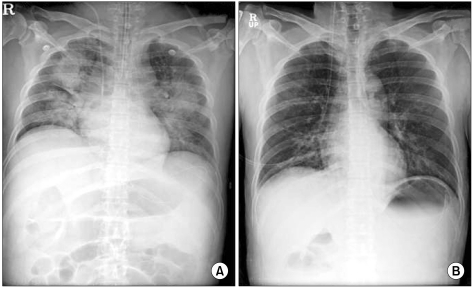Korean J Pain.
2012 Apr;25(2):126-129. 10.3344/kjp.2012.25.2.126.
Aspiration Pneumonitis Caused by Delayed Respiratory Depression Following Intrathecal Morphine Administration
- Affiliations
-
- 1Department of Anesthesiology and Pain Medicine, Gangneung Asan Medical Center, University of Ulsan Collage of Medicine, Gangneung, Korea. ykkim@gnah.co.kr
- 2Department of Anesthesiology and Pain Medicine, Asan Medical Center, University of Ulsan College of Medicine, Seoul, Korea.
- KMID: 1778999
- DOI: http://doi.org/10.3344/kjp.2012.25.2.126
Abstract
- Opioid analgesia is the primary pharmacologic intervention for managing pain. However, opioids can cause various adverse effects including pruritus, nausea, constipation, and sedation. Respiratory depression is the most fatal side effect. Therefore, cautious monitoring of respiratory status must be done after opioid administration. Here, we report a patient who suffered from respiratory depression with deep sedation and aspiration pneumonitis after intrathecal morphine administration.
Keyword
MeSH Terms
Figure
Reference
-
1. Lee SJ, Nam SK, Kim JH, Kim HJ, Lee SC, Kim YC. Implantation of an intrathecal drug Administration system: a report of two cases. Korean J Pain. 2009; 22:68–73.
Article2. Rhee SM, Choi EJ, Lee PB, Nahm FS. Catheter obstruction of intrathecal drug administration system -a case report-. Korean J Pain. 2012; 25:47–51. PMID: 22259717.
Article3. Chaney MA. Side effects of intrathecal and epidural opioids. Can J Anaesth. 1995; 42:891–903. PMID: 8706199.
Article4. Oderda GM, Said Q, Evans RS, Stoddard GJ, Lloyd J, Jackson K, et al. Opioid-related adverse drug events in surgical hospitalizations: impact on costs and length of stay. Ann Pharmacother. 2007; 41:400–406. PMID: 17341537.
Article5. Jarzyna D, Jungquist CR, Pasero C, Willens JS, Nisbet A, Oakes L, et al. American Society for Pain Management Nursing guidelines on monitoring for opioid-induced sedation and respiratory depression. Pain Manag Nurs. 2011; 12:118–145.e10. PMID: 21893302.
Article6. Abou Hammoud H, Simon N, Urien S, Riou B, Lechat P, Aubrun F. Intravenous morphine titration in immediate postoperative pain management: population kinetic-pharmacodynamic and logistic regression analysis. Pain. 2009; 144:139–146. PMID: 19435651.
Article7. Young-McCaughan S, Miaskowski C. Definition of and mechanism for opioid-induced sedation. Pain Manag Nurs. 2001; 2:84–97. PMID: 11710090.
Article8. Gustafsson LL, Schildt B, Jacobsen K. Adverse effects of extradural and intrathecal opiates: report of a nationwide survey in Sweden. Br J Anaesth. 1982; 54:479–486. PMID: 6896150.
Article9. Ruan X, Couch JP, Liu H, Shah RV, Wang F, Chiravuri S. Respiratory failure following delayed intrathecal morphine pump refill: a valuable, but costly lesson. Pain Physician. 2010; 13:337–341. PMID: 20648202.10. American Society of Anesthesiologists Task Force on Neuraxial Opioids. Horlocker TT, Burton AW, Connis RT, Hughes SC, Nickinovich DG, et al. Practice guidelines for the prevention, detection, and management of respiratory depression associated with neuraxial opioid administration. Anesthesiology. 2009; 110:218–230. PMID: 19194148.
Article
- Full Text Links
- Actions
-
Cited
- CITED
-
- Close
- Share
- Similar articles
-
- Prolongation of Tetracaine - Spinal Anesthesia by Intrathecal Morphine
- Intrathecal and Epidural Morphine for Postoperative Pain Control after Lumbar Laminectomy
- Respiratory Depression Induced by Intraarticular Morphine under Total Knee Replacement: A case report
- Respiratory Arrest following Intrathecal Administration of Morphine
- Treatment of Urinary Rstsntion due to Intrathecal Injection of Morphine


